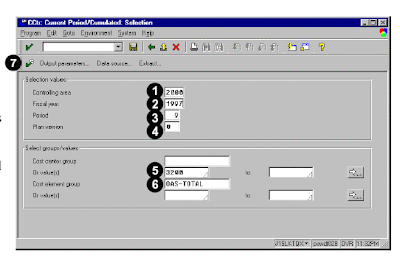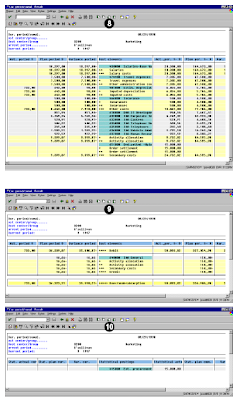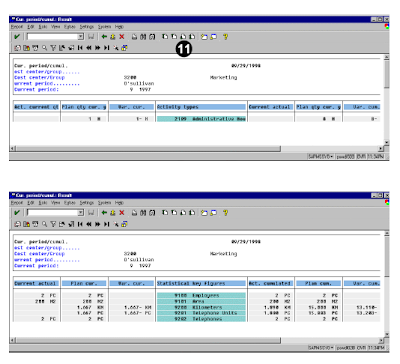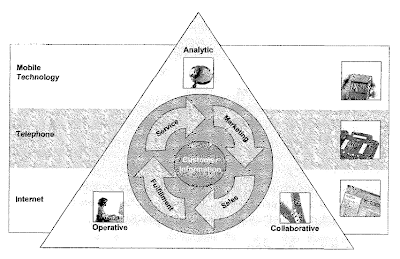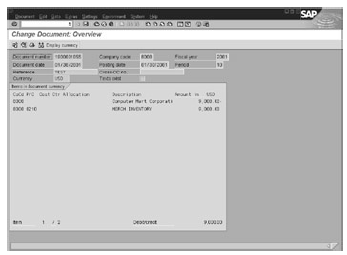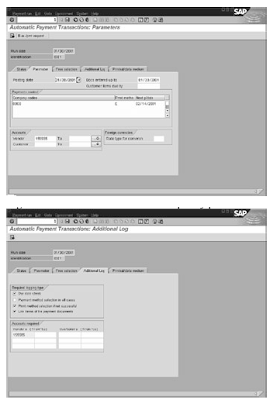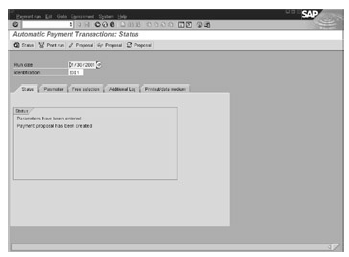MySAP CRM is a new generation customer relationship management software tool which helps the business better by making the customer more happy with the business service given by then company.
Isolated solutions for customer relationship management or logistics management, however powerful they may be are not enough to map and optimize cross application and cross-system business processes completely .Companies need applications that integrate seamlessly with others and enable system users to access information and functions required through a standardized interface. The Implementation, administration, and customizing of these cross-application and cross-system processes represent a great challenge SAP has met these challenges with the service-oriented concept of Enterprise Services Architecture .
MYSAP CRM is useful in integrating the following business process.
mySAP Customer Relationship Management
Customer-centric services for planning, creating, and maintaining customer relationships, giving particular consideration to new possibilities using the Internet, mobile devices, and multi-channel interaction. mySAP Customer Relationship Management (mySAP CRM) supports customer interaction in all phases of the customer interaction cycle—from first contact to closing the deal and on to order management and follow-on services. To enable analytical evaluations, mySAP CRM is tightly connected with mySAP Business intelligence (mySAP Bl) and integrates the functions of SAP Business Information Warehouse (SAP BW).
mySAP Supply Chain Management
With mySAP Supply Chain Management (mySAP SCM), customers, manufacturers, distribution partners, and suppliers can be included in cross-company logistics chains . mySAP SCM delivers transparency for stock, orders, forecasts, production planning, and performance key figures, which improves customer service (on-time delivery, online availability of order status in/ormatron. and so on), manufacturing efficiency, the abiftty to react to changes In demand, order processing time, and the amount of manufacturing capacity. The planning and optimizing component, SAP Advanced Planner and Optimizer SAP APO is a core component of my SAP CRM .
mySAP Business Intelligence
mySAP Business Intelligence B SAP's solution tor collecting and managing mternal and external data Its goal is to transfer this into business knowledge using data warehouse and analysis tools. mySAP Bl conusts of the components SAP BW. SAP Strategic Enterprise Management (SAP SEM), and SAP Knowledge Management (SAP KM). The component!of mySAP BI are tightly 1integrated With mySAP CRM .
mySAP Enterprise Resource Planning
mySAP Enterprise Resource Planning (mySAP ERP) offers companies an all encompassing solution for accounting, human resource management, business management, and company-internal services. SAP R/3 Enterprise, the latest version of SAP R/3. is an integral part of mySAP ERP. as are the functions of the SAP solutions mySAP Human Resources (mySAP HR) and mySAP Financials (mySAP Fl). mySAP HR and mySAP Fl are the well-known standard SAP solutions for all human resource management and financial reporting requirements .
mySAP Mobile Business
With mySAP Mobile Business, the mySAP Business Suite breaks away from the world of desktop PCs and local networks Mobile devices, such as laptops or handheld devices, alow users to access all solutions of the mySAP Business Suite at any time and from any place mySAP Mobile Business software.
mySAP Enterprise Portal
mySAP Enterprise Portal ts SAP's customizable, role-based enterprise portal for all users along the length of the value chain. An easy-to-understand. easy-to use and easy-to-customize browser interface enables users to access all company internal and company-external information, as well as applications and services that they need In their personal work environment The screen layout of mySAP Enterprise Portal is tailored to the individual user role in the company Each user can have more than one role and can switch between these roles as required.
mySAP Marketplace
mySAP Marketplace It a complete Infrastructure for building virtual, electronic marketplaces that can serve as platforms for processing Internet-based business transactions within virtual buyer and seller communities These marketplaces are a prerequisite for dynamic n:m business relationships instead of static contacts between predefined business partners mySAP Marketplace supports electronic auctions, automated bid Invitations, sou rang, procurement by self-service, as well as catalog and content management Users access mySAP Marketplace from mySAP Enterprise Portal The purchasing and selhrig systems connected to mySAP market place are connected by open interfaces in XML (Extensible Markup language)
SAP R/3 Enterprise, the current software version for existing SAP R/3 customers and a core component of the mySAP ERP solution. Company-internal processes, such as human resource management, accounting, product development, or inventory management, are mapped in SAP R/3 Enterprise SAP R/3 Enterprise is seamlessly integrated with other solutions of the mySAP Business Suite, and the best example is , with mySAP CRM.
SAP R/3 Enterprise consists of three basic functionality areas like
SAP R/3 Enterprise is based on the new technology SAP Netweaver and it offers a flexible enhancement concept basing on SAP R/3 Enterprise Extensions.
These enhancements are available tor the following application areas
Related Posts:
Customer Relationship Management and mysap an introduction
CRM Management and sales and service strategy of mysap crm
MySAP CRM and customer as business partner
How Customer Relationship management makes company Leader
CRM Uses and how to get best results with CRM
Isolated solutions for customer relationship management or logistics management, however powerful they may be are not enough to map and optimize cross application and cross-system business processes completely .Companies need applications that integrate seamlessly with others and enable system users to access information and functions required through a standardized interface. The Implementation, administration, and customizing of these cross-application and cross-system processes represent a great challenge SAP has met these challenges with the service-oriented concept of Enterprise Services Architecture .
MYSAP CRM is useful in integrating the following business process.
- • Business scenarios and processes (business solutions)
- • Business applications
- • integration and application Infrastructure
- • Computing infrastructure
mySAP Customer Relationship Management
Customer-centric services for planning, creating, and maintaining customer relationships, giving particular consideration to new possibilities using the Internet, mobile devices, and multi-channel interaction. mySAP Customer Relationship Management (mySAP CRM) supports customer interaction in all phases of the customer interaction cycle—from first contact to closing the deal and on to order management and follow-on services. To enable analytical evaluations, mySAP CRM is tightly connected with mySAP Business intelligence (mySAP Bl) and integrates the functions of SAP Business Information Warehouse (SAP BW).
mySAP Supply Chain Management
With mySAP Supply Chain Management (mySAP SCM), customers, manufacturers, distribution partners, and suppliers can be included in cross-company logistics chains . mySAP SCM delivers transparency for stock, orders, forecasts, production planning, and performance key figures, which improves customer service (on-time delivery, online availability of order status in/ormatron. and so on), manufacturing efficiency, the abiftty to react to changes In demand, order processing time, and the amount of manufacturing capacity. The planning and optimizing component, SAP Advanced Planner and Optimizer SAP APO is a core component of my SAP CRM .
mySAP Business Intelligence
mySAP Business Intelligence B SAP's solution tor collecting and managing mternal and external data Its goal is to transfer this into business knowledge using data warehouse and analysis tools. mySAP Bl conusts of the components SAP BW. SAP Strategic Enterprise Management (SAP SEM), and SAP Knowledge Management (SAP KM). The component!of mySAP BI are tightly 1integrated With mySAP CRM .
mySAP Enterprise Resource Planning
mySAP Enterprise Resource Planning (mySAP ERP) offers companies an all encompassing solution for accounting, human resource management, business management, and company-internal services. SAP R/3 Enterprise, the latest version of SAP R/3. is an integral part of mySAP ERP. as are the functions of the SAP solutions mySAP Human Resources (mySAP HR) and mySAP Financials (mySAP Fl). mySAP HR and mySAP Fl are the well-known standard SAP solutions for all human resource management and financial reporting requirements .
mySAP Mobile Business
With mySAP Mobile Business, the mySAP Business Suite breaks away from the world of desktop PCs and local networks Mobile devices, such as laptops or handheld devices, alow users to access all solutions of the mySAP Business Suite at any time and from any place mySAP Mobile Business software.
mySAP Enterprise Portal
mySAP Enterprise Portal ts SAP's customizable, role-based enterprise portal for all users along the length of the value chain. An easy-to-understand. easy-to use and easy-to-customize browser interface enables users to access all company internal and company-external information, as well as applications and services that they need In their personal work environment The screen layout of mySAP Enterprise Portal is tailored to the individual user role in the company Each user can have more than one role and can switch between these roles as required.
mySAP Marketplace
mySAP Marketplace It a complete Infrastructure for building virtual, electronic marketplaces that can serve as platforms for processing Internet-based business transactions within virtual buyer and seller communities These marketplaces are a prerequisite for dynamic n:m business relationships instead of static contacts between predefined business partners mySAP Marketplace supports electronic auctions, automated bid Invitations, sou rang, procurement by self-service, as well as catalog and content management Users access mySAP Marketplace from mySAP Enterprise Portal The purchasing and selhrig systems connected to mySAP market place are connected by open interfaces in XML (Extensible Markup language)
SAP R/3 Enterprise, the current software version for existing SAP R/3 customers and a core component of the mySAP ERP solution. Company-internal processes, such as human resource management, accounting, product development, or inventory management, are mapped in SAP R/3 Enterprise SAP R/3 Enterprise is seamlessly integrated with other solutions of the mySAP Business Suite, and the best example is , with mySAP CRM.
SAP R/3 Enterprise consists of three basic functionality areas like
- • Functionality from the previous release (SAP R/3 4 60. combined In SAP R/3 Enterprise Core
- • Functional enhancements that are packaged in SAP R/3 Enterprise Extensions
- • The technological platform SAP NetWeaver which, along with a stable application server, offers tools for integrating people, information, and processes
SAP R/3 Enterprise is based on the new technology SAP Netweaver and it offers a flexible enhancement concept basing on SAP R/3 Enterprise Extensions.
These enhancements are available tor the following application areas
- Human resource management (MR)
- Travel management (TM)
- Accounting (Fl)
- Product development/Product Lifecyde Management (PIA1)
- Logistics (SCM)
Related Posts:
Customer Relationship Management and mysap an introduction
CRM Management and sales and service strategy of mysap crm
MySAP CRM and customer as business partner
How Customer Relationship management makes company Leader
CRM Uses and how to get best results with CRM
